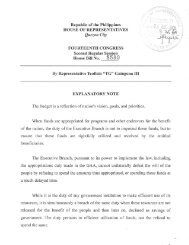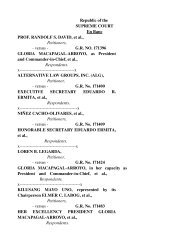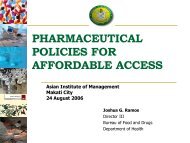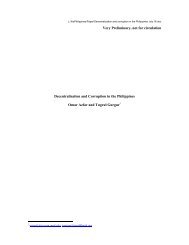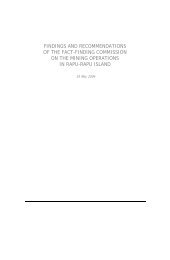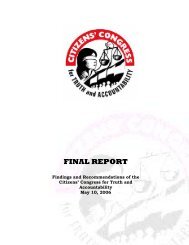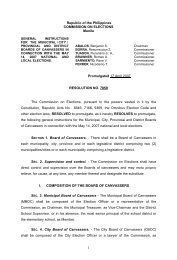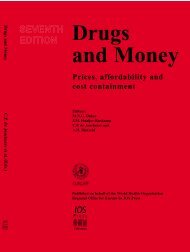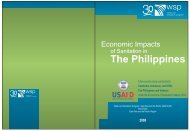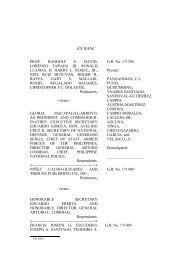The state of water resources in the Philippines - Greenpeace
The state of water resources in the Philippines - Greenpeace
The state of water resources in the Philippines - Greenpeace
You also want an ePaper? Increase the reach of your titles
YUMPU automatically turns print PDFs into web optimized ePapers that Google loves.
Introduction<br />
This report ga<strong>the</strong>rs available <strong>in</strong>formation regard<strong>in</strong>g <strong>water</strong> <strong>resources</strong> <strong>in</strong> <strong>the</strong><br />
Philipp<strong>in</strong>es, focus<strong>in</strong>g on <strong>the</strong> issues <strong>of</strong> pollution, especially <strong>of</strong> dr<strong>in</strong>k<strong>in</strong>g <strong>water</strong> and<br />
fresh<strong>water</strong> sources, and <strong>water</strong> scarcity. It also reviews <strong>the</strong> country’s exist<strong>in</strong>g<br />
legal and policy frameworks for <strong>water</strong> use, quality control, and management.<br />
In an attempt to capture <strong>the</strong> complexity surround<strong>in</strong>g <strong>the</strong> status <strong>of</strong> <strong>water</strong><br />
<strong>resources</strong>, this report is presented <strong>in</strong> six parts. <strong>The</strong> first section focuses on <strong>the</strong><br />
general status <strong>of</strong> availability <strong>of</strong> fresh<strong>water</strong> <strong>resources</strong>, both surface <strong>water</strong>s (rivers,<br />
lakes, and reservoirs) and ground<strong>water</strong> sources. Section 2 follows with a<br />
discussion on <strong>water</strong> quality. This consists <strong>of</strong> <strong>the</strong> follow<strong>in</strong>g sub-topics:<br />
classification <strong>of</strong> surface <strong>water</strong>s, standards used <strong>in</strong> classification and subsequent<br />
monitor<strong>in</strong>g <strong>of</strong> <strong>water</strong> bodies, impacts on health and <strong>the</strong> environment, and efforts to<br />
address problems on <strong>water</strong> quality. This part <strong>of</strong> <strong>the</strong> report also presents<br />
‘pollution hotspots’--areas that generate <strong>the</strong> highest volume <strong>of</strong> <strong>water</strong> pollution<br />
and/or are severely affected by <strong>water</strong> pollution.<br />
<strong>The</strong> status <strong>of</strong> <strong>water</strong> use and supply is presented <strong>in</strong> Section 3. This part <strong>of</strong> <strong>the</strong><br />
report focuses on actual usage <strong>of</strong> <strong>water</strong> <strong>resources</strong> by different consumers.<br />
Different issues perta<strong>in</strong><strong>in</strong>g to <strong>water</strong> use are also identified, <strong>in</strong>clud<strong>in</strong>g <strong>the</strong> issue on<br />
access to potable dr<strong>in</strong>k<strong>in</strong>g <strong>water</strong> itself. Over and above <strong>the</strong>se problems, <strong>the</strong><br />
report presents <strong>in</strong> this section o<strong>the</strong>r factors that threaten not only <strong>water</strong> supply<br />
but also threaten <strong>the</strong> availability <strong>of</strong> <strong>water</strong> sources from which supply is withdrawn.<br />
Section 4 presents a review <strong>of</strong> <strong>the</strong> exist<strong>in</strong>g legal and policy frameworks for <strong>water</strong><br />
<strong>resources</strong> <strong>in</strong> <strong>the</strong> Philipp<strong>in</strong>es. This <strong>in</strong>cludes a discussion on exist<strong>in</strong>g guidel<strong>in</strong>es<br />
and standards used to regulate <strong>water</strong> use and supply, ensure <strong>water</strong> quality, and<br />
presents <strong>the</strong> status <strong>of</strong> <strong>the</strong> enforcement <strong>of</strong> <strong>the</strong>se policies and guidel<strong>in</strong>es.<br />
Efforts to <strong>in</strong>itiate and implement Clean Production (CP) programs are <strong>the</strong>n<br />
presented <strong>in</strong> Section 5, which <strong>in</strong>cludes a list <strong>of</strong> key CP <strong>in</strong>itiatives and concerned<br />
agencies/<strong>in</strong>stitutions <strong>in</strong>volved <strong>in</strong> this endeavor.<br />
<strong>The</strong> sixth topic, which is <strong>the</strong> last section <strong>of</strong> this report, conta<strong>in</strong>s <strong>the</strong> list <strong>of</strong><br />
available reports on <strong>water</strong> <strong>in</strong> <strong>the</strong> Philipp<strong>in</strong>es and materials that may be used as<br />
reference for future studies.<br />
GREENPEACE | <strong>The</strong> <strong>state</strong> <strong>of</strong> <strong>water</strong> <strong>in</strong> <strong>the</strong> Philipp<strong>in</strong>es 10



